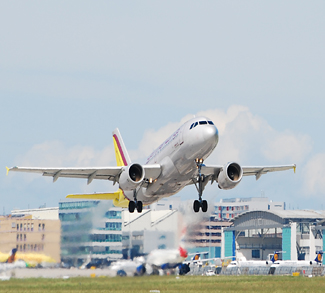Co-pilot Andreas Lubitz did not suffer from any illness and there was nothing to indicate terrorism. He was alive until the instant of impact. “Neither he or the captain are classified as terrorists,” said the prosecutor in charge of the investigation of the March 25th crash of the Germanwings Airbus 320, Flight 4U 9525, from Barcelona to Dusseldorf. German police claim to have found evidence described as ‘significant’ in helping to explain Lubitz’s state of mind and his actions in the cabin. According to audio recovered from the voice recorder, the captain had left the cabin only to be denied entry by Lubitz, who could have opened the door (normally in a locked mode) by the flick of a switch on the control panel.
Difficult as it is to accept the conclusions of the investigators of the Germanwings crash, cases of suicide are very rare – but they are possible. In the recent history of civil aviation there are at least three other cases in which the suicidal efforts of one of the pilots have led to the crash of an airliner and the death of everyone on board. The oldest confirmed case goes back to August 21, 1994, when a Royal Air Maroc ATR42 was flown nose-first into the ground near the city of Agadir in Morocco. In 1997, in Singapore, a Boeing 737-300, brand new, was brought down by a co-pilot who was experiencing a difficult period in his life; and in 1999, an Egyptair Boeing 747, headed for Cairo, was deliberately crashed into the Atlantic Ocean.
Many airlines around the world have issued a new rule which demands that there always be at least two people in the cabin in order to reduce the chances of another pilot carrying out a suicide mission. Doubtlessly, psychological evaluations will likely be intensified, but there is little else they can do other than develop new technologies that interfere with a pilot’s attempt to cause a deliberate and rapid descent.
Nevertheless, one aspect of the industry that will no doubt be examined is the level of stress on air crews imposed by ever more stringent cost control measures, many of which are linked to the industry’s expanding ‘low-cost’ phenomenon.
Airliners and commercial aviation, as difficult as it may be to believe in the wake of an accident that claimed the lives of 150 people, has never been safer according to data from the International Air Transport Association (IATA). In 2014, deaths from air accidents stood at 641, not including the 298 victims of the Malaysia Airlines Boeing 777 that was hit by a missile in Ukraine last July. In 2013, the number was twice as high. These are very low numbers compared to those of road accident victims worldwide – over a million per year. Technology is ever more refined, ensuring greater safety for passengers and air crews. Yet, there are cases of pilots warning that financial pressures are inevitably leading to rules that exceed the boundaries of good practices.
In the case of Germanwings, this is an airline that was founded in 1997, when it was called Eurowings Flug. The Lufthansa Group bought it in 2008, using it as its low-cost subsidiary. Over time, Germanwings has increasingly occupied the heart of Lufthansa’s development strategy. In 2012, the German national airline announced that within three years it would shift all its short and medium haul flight operations to Germanwings, except for those departing from the Munich and Frankfurt hubs. As part of the strategy, Lufthansa airplanes would be transferred to the low cost carrier. Germanwings now has a fleet of 90 airplanes. At the end of 2015, the Germanwings brand will be replaced by Eurowings.
This strategy has resulted in a long series of pilot strikes and other labor disputes at Lufthansa. Germanwings offers worse contractual conditions than Lufthansa, especially with regard to retirement age. An initial three-day national strike was held in April 2014, and a second one was held in September. In 2015, there have been a total of six days of strikes, the last of which lasted four days and ended on 22 March. After the crash was announced, Lufthansa shares lost much altitude, falling 5% around noon.
Lufthansa is hardly unique. Other mainstream airlines have adopted low-cost standards, including Air France (operating through Transavia) and IAG (British Airways-Iberia) with Iberia Express and Vueling. The Germanwings accident, indirectly, brings into question the strategy of large European companies and their plans to shift more operations to low-cost carriers. The problem, it must be stressed, has nothing to do with the safety standards themselves, which are the same for all airlines, regardless of class or category. Indeed, budget airlines such as easyJet and Ryanair have been shown to maintain excellent safety levels, especially given their very high number of flights.
The problem has more to do with human resources than mechanical ones. There is evidence of a progressive worsening of pilots’ working conditions, which is having negative financial and safety consequences. In the USA, following an air accident in 2014, the Federal Aviation Authority demanded that the maximum working shift be set at nine hours, and for long stretches, the presence of three pilots would be required. Similar precautions have yet to be taken in Europe, where shifts with only two pilots on board regularly exceed eight hours, compromising the safety of the passengers and crew. There is also the growing problem of low wages. In February 2009, a Colgan Air Bombardier Q-400 turboprop crashed into a house in Clarence Centre, NY. The National Transportation Safety Board (NTSB), ruled the accident was caused by the pilots’ “inability to respond properly to the stall warnings.”
This inability was attributed to fatigue and ultimately to low wages. Families of the victims lobbied the US Congress to adopt tougher regulations for regional carriers and enforce rules to improve working conditions for pilots. One of the pilots on that plane was earning little more than minimum wage ($16,000/year) and supplementing her income by moonlighting at a fast food restaurant. Colgan Air has since changed its hiring practices. But, this phenomenon has in no way been eliminated; if anything it has gotten worse thanks to the so called practice of “pay to fly.” Young pilots, still in training, often pay to fly in order to prevent their license from expiring while they wait to be hired. They are required to fly a certain number of hours per year and are willing to offer themselves as “volunteer co-pilots,” or even to work anywhere in the cabin. But it is mainly the safety conditions at work that concern crews. Some pilots speak of having worked shifts of four days, sleeping no more than ten hours. Clearly, flight time limits must be adopted in order to ensure higher levels of safety as financial pressures have led many to fly beyond the limits.
There is no evidence that the Germanwings pilot who crashed his plane into a mountainside was suffering from any particular preoccupation over wages, or that he was moonlighting as a short order cook. But those stresses can lead to mistakes in the cockpit that have the same end result as those of a well-paid though suicidal pilot. Ultimately the Germanwings accident shows that mental stress is a problem. In the case of Lubitz, the problem appears to have been of an intimate nature and hidden from his colleagues and employers; in other cases however, there are identifiable issues and solutions that are to be found in better management and better working conditions.
The opinions, beliefs, and viewpoints expressed by the authors are theirs alone and don’t reflect any official position of Geopoliticalmonitor.com.




